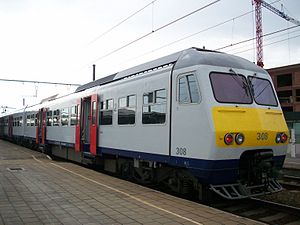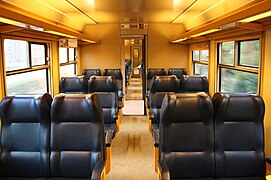NMBS / SNCB series AM 80
| NMBS / SNCB series AM 80 | |
|---|---|
|
AM 80 in the paint scheme from 2009 in Kortrijk
|
|
| Numbering: | 301-440 |
| Number: | 140 |
| Manufacturer: | ACEC , BN |
| Year of construction (s): | 1980-1985 |
| Axis formula : | Bo'Bo '+ 2'2' + 2'2 ' |
| Genre : | ABDx + B + Bx |
| Gauge : | 1435 mm ( standard gauge ) |
| Length over coupling: | 75,810 mm |
| Length: | 25,425 mm ( railcar / control car) 24,960 ( intermediate car) |
| Height: | 4,392 mm |
| Width: | 2,800 mm |
| Trunnion Distance: | 18,200 mm ( railcar / control car) 18,110 mm ( intermediate car) |
| Bogie axle base: | 2,800 mm (railcar / control car) 2,560 mm (intermediate car) |
| Smallest bef. Radius: | 125 m |
| Service mass: | 151.0 t, of which 60.0 t (multiple units) 44.0 t (intermediate car) 47.0 t (control car) |
| Top speed: | 160 km / h |
| Hourly output : | 1,240 kW |
| Acceleration: | 0.54 m / s² |
| Driving wheel diameter: | 1,010 mm |
| Impeller diameter: | 950 mm |
| Power system : | 3 kV DC |
| Power transmission: | Overhead line |
| Number of traction motors: | 4th |
| Coupling type: | + GF + coupling |
| Seats: | 254 |
| Floor height: | 960 mm |
The series AM 80 and its successors AM 82 and AM 83 of the Belgian State Railways (NMBS / SNCB) are a 140-piece series of three-part electric railcars for inner-Belgian InterCity and InterRegio traffic. The vehicles are also known as “Break” in French .
history
The initially two-part trains were built from 1980 by a consortium of Ateliers de constructions électriques de Charleroi (ACEC) and La Brugeoise et Nivelles (BN), in order to be used in long-distance transport within Belgium from 1984 at an operating speed of up to 160 km / h. With the introduction of the IC and IR train types , the multiple units of the AM 80 series became the new flagship of the Belgian state railways and the first non-locomotive-hauled trains that could reach speeds of over 140 km / h. In contrast to their predecessors, the trains have automatic + GF + couplings . An operational coupling is therefore not possible with these.
In addition, 16 three-part units were built for the Moroccan State Railways , which were delivered in beige with dark red wide ribbon windows and doors, with two additional small headlights and the “Seal of Salomon ” (Green Star) in the middle .
The short train length as well as the type of coupling meant that with an increase in capacity only the AM 80 could be coupled with each other, so that ultimately fewer trains were available. The NMBS / SNCB therefore decided in 1990 to add an intermediate car to the trains, which had a significantly better interior design compared to the heads . The cars were converted between 1992 and 1995 in the Mechelen repair shop . At the same time, they were given a new paint job in gray with blue and red stripes in the then current Memling color scheme of the SNCB.
The AM 80 were initially used on the routes from Brussels to Luxembourg and the North Sea coast from their commissioning . The Luxembourg state railway CFL acquired two AM-80 units (Tw 325 and 326) from the SNCB for this purpose. AM 80 vehicles now operate on all major routes on the Belgian rail network. The main area of application is the connection from the Belgian capital to Brussels-Zaventem Airport , but also in local transport e.g. B. in the eastern part of Belgium. The trains can be found in all train types (IC, L, P). For use at the airport, the sets 401 to 405 were given the label Brussels Airport Express in 1998 .
The vehicles have been modernized again since 2009 and EUR 216 million invested. You will receive the latest New Look color scheme from Belgian railways. In the interior, the wall paneling will also be renewed and the previous seats will be reupholstered. Air conditioning is not installed, which is why the vehicles should preferably no longer be used in intercity services. Some of these compounds are being passed on to the newer AM 96 series models .
technology
The three-part units consist of a control car , an intermediate car and a powered end car. The driven car has four drive motors with an hourly output of 310 kW. The automatic coupling of the trains in combination with the multiple control enables up to 6 railcars to be connected. For removal of electrical power from the catenary are Einholmstromabnehmer the British company Brecknell Willis used. The end cars are equipped with Wegmann bogies , while the intermediate cars that were added later have air-sprung running bogies from the Italian manufacturer Fiat , which are identical to the AM 96 bogies .
photos
Web links
- Automotrices AM 80. belrail.be, September 11, 2004, accessed on May 19, 2013 (French).
Individual evidence
- ↑ a b c d Klaus Ecker, Torsten Berndt: 1000 Locomotives: History - Classics - Technology , Naumann & Göbel Verlagsgesellschaft, Cologne 2004, ISBN 3-625-10541-1 , p. 25
- ↑ Thierry Nicolas: Typr AM 80 - Reeks / Series 301-440 . Ed .: Nicolas Collection. ISBN 978-2-930748-54-2 .
- ↑ NMBS modernizeert 139 treinstellen type Break , treinreiziger.nl from October 28, 2009






